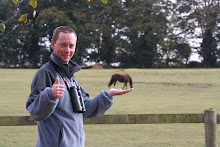The weather has been in the east now for the last week and it has gone very quiet. As with most, if not all migration sites, when the conditions are right they offer some of the best birding you can imagine. When the conditions are not right it can be very tough going.
Today was one of those days.
Started off at Higbee Wood but it was a real struggle to find any warblers. The few that were around were very mobile and I only managed to get onto an American redstart and a probable blackpoll warbler so i gave up after an hour.
Dropped in to see if Patti was banding but I think the early rain had put her off so it was on to Lily Lake.
Things were slow but there did seem to be more cardinals about and there was a nice movement of blue jays. They are only resident in small numbers so a flock of 79 over were definitely migrants.
There really didn't seem to be any birds until we came across a feeding flock in some cedars. The majority of the flock was at least 20 yellow rumped warblers but there was also 4 'tooting' red breasted nuthatch, ruby crowned kinglet, several chickadee, yellow warbler and 2 Cape May warblers, one of which was a very smart male. The flock was very mobile and almost as soon as we had found them they were gone!
All nice stuff but its nothing like last week.
WE NEED A WESTERLY WEATHER FRONT PLEEEEEEASE





























































